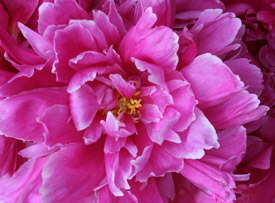
story & photo by Linda Wiggen Kraft
Smell is the most direct experience of all sensual pleasures. Olfactory cells link directly to our brains in the areas of memory and emotion. Smelling garden fragrances can be a healthy life enhancing experience, or it can bring a stew of toxic chemicals into your body and bloodstream when artificial garden fragrances used in soaps, detergents, air fresheners, drier sheets, cleaning products, cosmetics and other common items are used.
Molecules of fragrance, real or synthetic, are sent into the air from things in the environment. These molecules are absorbed into the body when inhaled. These scents also penetrate skin to enter both bloodstream and other body systems when part of lotions, soaps, deodorant and cosmetics. Unfortunately synthetic fragrances are marketed to appear as natural, pure and healthy as the real thing, which is not the case at all. Even “fragrance free” products often use a neutralizing fragrance to cover up other fragrances.
What are the differences between real and synthetic? Real fragrance from the garden is made of molecules that have good and positive effects on health and emotional well-being. Although preferences for scents are personal, there are benefits for most people from certain plants. For example, lavender is used to relax and calm. Peppermint helps with alertness, memory and cognition. The scent of molecules from plants is complex and has been used for thousands of years. Their long-term effects are known.
Synthetic fragrances are only a few decades old. About 95% are derived from toxic petrochemical sources, which build up in the body with bad results. Repeated exposure has been linked to endocrine disruption and several types of cancer. Allergies, asthma and other respiratory problems can be triggered. Synthetic fragrances are not required to list the stew of chemicals on the product label. They are only required to list the term “fragrance”.
If you love the scents of the garden what can be done? Bring the real thing into your life. Flowers and fragrant foliage can be part of bouquets kept in the house. Herbs are some of the most fragrant. A bouquet of basil, oregano or rosemary smells great in the kitchen. Add garden fragrances to the bath, either floating on the water or held in a netting or bag.
Fragrances can be found in flowers, leaves, bark, roots and all parts of plants. Get up close to smell the sometimes subtle scents. Crush leaves to see if they hold pleasant smells. Often flowers that grow in your garden, and aren’t ever sold in stores, have enchanting fragrances like petunia, marigold, flowering tobacco and dianthus. The native grass prairie dropseed has an herb like smell in late summer. Fragrances that come directly from nature also carry the energy of the garden and the plant, something a synthetic will never have.
For cosmetic and household products needed, find products without the word “fragrance”. Check out “fragrance free” or “unscented” products, they may contain a masking fragrance. Research online or with a phone call to ask the manufacturer or store selling the product what is used to create the scent in the product. If true scents from the garden delight you, add essential oils to home and other products, or find products that only use these scents.
With hot summer days still burning bright, bring the real and true fragrances of the garden into your life for a sensual delight. But don’t forget to have real fragrance in all seasons. Explore your own garden to find year round delightful scents.
Linda Wiggen Kraft is a landscape designer, mandala artist, photographer and meditation teacher. Her work can be seen on her website and blog: www.CreativityForTheSoul.com.


